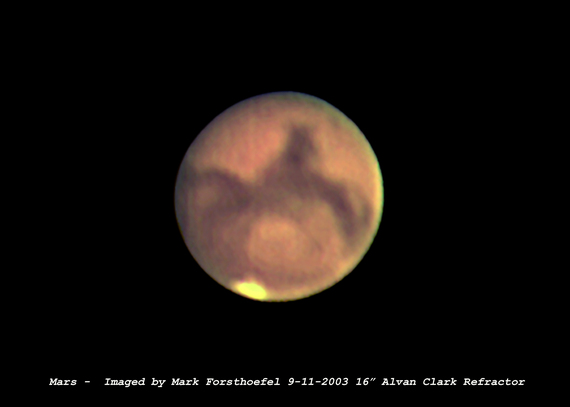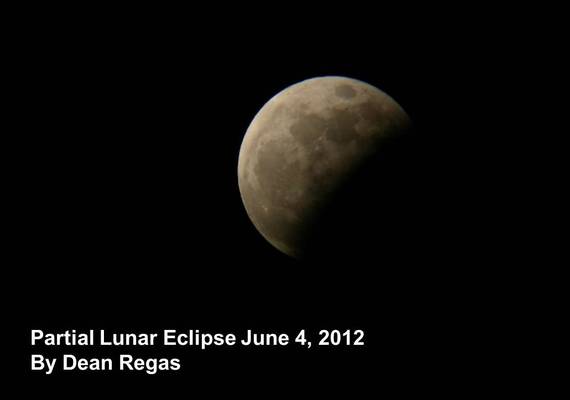Backyard astronomers, get ready to feast your eyes on the skies. In April the red planet returns to prime time, and the Moon shows us a darker side.
Marsapalooza (April 10-12, 2014)
There is no doubt that Mars is the primary holder of the planetary fascination of our nation. Some people are more interested in Mars than in Earth. At the Cincinnati Observatory public programs about Mars are consistently the most popular. Every 26 months Mars reaches its closest point to the Earth, and the Mars-loving public whips itself into a frenzy in order to take a closer look at the red planet through our telescopes. We lovingly call this "Marsapalooza."
In 2003 we opened the telescopes to the public on the night that Mars was closer to us than it had been for over 60,000 years. Lines formed at our two telescopes at dusk and stretched out the door and down the block. Our volunteers entertained the crowd until the final visitor viewed Mars at 4:30 a.m.
What motivates a person to stand in line for hours to get one glimpse of a tiny planet when it is slightly closer to Earth than normal? What were the visitors hoping to see through the telescope? What is this power that Mars holds over us? I have only one explanation: Martians.
Was there ever life on Mars? Is life there today? These questions have bounced around the minds of science-fact and science-fiction writers for centuries. In H.G. Wells' time people, squinting through the best telescopes, thought they saw canals on the surface of Mars -- evidence of an alien civilization desperate for water. The first spacecrafts flew by in the 1960s and saw only a dry, cracked, and cratered world -- no canals. There's no way that life could exist on Mars, right? Not so fast! Now, with three orbiters flying around it and two rovers rolling on it, we know that Mars has had liquid water on its surface. Flowing water shaped its terrain. Maybe life was there; maybe life is there!
During Marsapalooza you can investigate the red planet yourself. Check with your local observatory, planetarium, science center, or astronomy club to see what events they have scheduled. To the naked eye Mars will look like a bright-orange star in the eastern sky a little after sunset. You'll be seeing a lot of Mars, because it'll be up every night until the end of the year. Each day the Earth will pull a little farther away from it until the next closest approach, the next Marsapalooza, in May 2016.
Tax Day Lunar Eclipse (April 15, 2014)
During a total lunar eclipse the Sun, Earth, and Moon are in perfect alignment. The full Moon orbits into the shadow of the Earth, which turns the lunar surface an eerie shade of orange. Lunar eclipses scared the hell out of the ancients, the Moon's color inspiring fear and dread. The next lunar eclipse will occur on the modern American's day of dread: April 15.
You will have to get up really early or stay up really late to watch this eclipse. The show begins at about 2 a.m. Eastern Daylight Time (EDT), when you will start to see the rounded shadow of the Earth appear on the disc of the full Moon. Then, over the course of an hour, the shadow will cover more and more of the Moon's surface until the moment when the Moon will be completely in the shadow of the Earth. This is called "totality," and it will occur on April 15 from 3:06 a.m. to 4:25 a.m. EDT.
During totality the Moon will not disappear but will instead turn a different shade. Astronomers cannot predict what color it will be -- pale gray, bright orange, or blood red. Only the shadow knows! Some sunlight will still reach the surface of the Moon. It bends through the Earth's atmosphere and gives the Moon its unique mood lighting. Whatever the color, when you see the total lunar eclipse, you are actually seeing all the sunsets and sunrises of Earth projected onto the Moon.
After totality ends, you can watch the Moon slowly move out of the Earth's shadow. The full Moon will appear to be its normal, bright self again at around 5:30 a.m. After that you will have only a few short hours to mail in your taxes, or this total lunar eclipse could signal doom and gloom for you.
Get up and get out to witness the heavenly dances this April.
Keep looking up!


